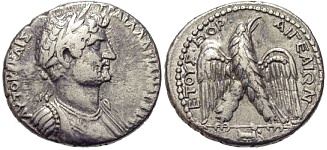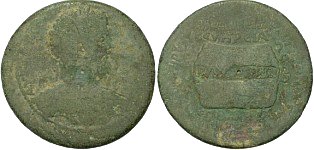Fine Coins Showcase
Antiquities Showcase
Show Empty Categories
Shop Search
Shopping Cart
My FORVM
Contact Us
About Forum
Shopping at Forum
Our Guarantee
Payment Options
Shipping Options & Fees
Privacy & Security
Forum Staff
Selling Your Coins
Identifying Your Coin
FAQs
zoom.asp
Home ▸ Catalog ▸ |Greek Coins| ▸ |Greek Imperial| ▸ |Asia Minor & Cyprus||View Options:   | | | | | | |


Aegeae issued tetradrachms only during the reigns of Hadrian and Caracalla. The issues were probably related to visits of these emperors to the town or to its famous sanctuary of Asclepius. -- The Syro-Phoenician Tetradrachms and Their Fractions from 57 BC to AD 253 by Michel and Karin PrieurSH26531. Silver tetradrachm, Prieur 720 (1 example), SNG BnF 2331, Weber -, VF, weight 13.043 g, maximum diameter 26.9 mm, die axis 180o, Aigeai (near Yumurtalik, Turkey) mint, 132 - 133 A.D.; obverse AYTOKP KAIΣ TPAIA AΔPIANO ΣEB Π Π, laureate, draped, and cuirassed bust right; reverse ETOYΣ ?ΘOP? AIΓEAIΩN, eagle standing facing on harpe, wings spread, head turned right, goat in ex; rare; SOLD
Severus Alexander, 13 March 222 - March 235 A.D., Nicaea, Bithynia


Asclepius, the son of Apollo and Koronis, learned the secrets of keeping death at bay after observing one snake bringing another snake healing herbs. Hygieia, the goddess of health, was his daughter with Minerva. Woman seeking fertility, the sick, and the injured slept in Asclepius' temples in chambers where non-poisonous snakes were left to crawl on the floor and provide healing.RP28308. Bronze AE 27, SNGvA 610, Rec Gen II.3 -, BMC Pontus -; SNG Cop -, Lindgren -, VF, weight 8.075 g, maximum diameter 27.4 mm, die axis 0o, Nicaea (Iznik, Turkey) mint, obverse M AYP CEYH AΛEΞAΔPOC AY or similar, laureate, draped, and cuirassed bust right, seen from behind; reverse NIKA/IEΩN, on left Hygieia seated and feeding snake, on right Asklepios leaning on snake-entwined staff, in center statue on cippus, tree behind, countermark right; very nice green patina; very rare reverse type; SOLD
Commodus, March or April 177 - 31 December 192 A.D., Amaseia, Pontos


Pontus, Amaseia is in modern day Turkey and is described in Price and Trell as one of the most impressive sites in that country. According to Price and Trell, the sanctuary to Zeus Statios, the chief deity of Amaseia, was not actually at Amaseia itself, but to the East, behind a mountain, on the high plateau at Buyuk Evlia. The great monumental altar to Zeus Stratios is always accompanied by a tree or flower, which would seem to have some connection with the cult.SH32542. Orichalcum sestertius, Price-Trell 163 for type; Waddington, p. 32., aVF, weight 23.167 g, maximum diameter 31.3 mm, die axis 0o, Amaseia (Amasya, Turkey) mint, obverse M AV [...] KOMO-ANTΩNOC, laureate and draped bust right from behind; reverse AMACEIT MHTP NEΩKΠPT ΠONT ITPΠO, eagle standing on top of altar of Zeus Stratios, Helios in facing quadriga above, sacred tree to left; ex Zach Beasley architectural coins collection; scarce; SOLD
Trajan, 25 January 98 - 8 or 9 August 117 A.D., Cyprus


A worn but fine Rome mint style portrait. It is possible these coins were struck in Rome, or a Rome mint die engraver traveled to Cyprus; most likely, the dies were cut in Rome and sent to Cyprus.RP82293. Orichalcum provincial sestertius, BMC Cyprus p. 83, 40, gF, weight 24.024 g, maximum diameter 33.7 mm, die axis 180o, Cyprus mint, c. 115 - 117 A.D.; obverse AYTOKP KAIC NEP TPAIANO APICT CEB ΓEPM ΔAK, laureate and draped bust right; reverse ΔHMAPX EΞ YΠATOΣ KOINON KYΠPIΩN, Zeus Salaminios standing, patera in right, eagle in left; rare; SOLD
Vespasian, 1 July 69 - 24 June 79 A.D., Caesarea, Cappadocia, Titus Reverse


Kayseri, originally called Mazaka or Mazaca, is in central Turkey on a low spur on the north side of Mount Erciyes (Mount Argaeus in ancient times). During Achaemenid Persian rule, it was the capital of a Satrapy on the crossroads of the Royal Road from Sardis to Susa and the trade route from Sinope to the Euphrates. It was conquered by Alexander's general Perdikkas, was ruled by Eumenes of Cardia, then passed to the Seleucid empire after the battle of Ipsus. It became the capital of the independent Cappadocian Kingdom under Ariarathes III, around 250 B.C. During Strabo's time it was also known as Eusebia, after the Cappadocian King Ariarathes V Eusebes, 163 – 130 B.C. The name was changed again to "Caesarea in Cappadocia" in honor of Caesar Augustus, upon his death in 14 A.D. The city passed under formal Roman rule in 17 A.D. In Roman times, it prospered on the route from Ephesus to the East. Caesarea was destroyed by the Sassanid King Shapur I after his victory over the Emperor Valerian I in 260 A.D. At the time it was recorded to have around 400,000 inhabitants. Arabic influence changed Caesarea to the modern name Kayseri. The city gradually recovered and has a population of almost 1 million people today. Few traces of the ancient city survive.SH48358. Silver didrachm, RPC II 1647, Sydenham 89, VF, superb portrait, weight 7.199 g, maximum diameter 20.4 mm, die axis 0o, Cappadocia, Caesarea (Kayseri, Turkey) mint, 77 - 78 A.D.; obverse AYTOKPA KAICAP OYECΠACIANOC CEBACTOC, laureate bust of Vespasian right; reverse NIKH CEBACTH, Nike advancing right, wreath in extended right hand, palm over shoulder in left; SOLD
Septimius Severus, 9 April 193 - 4 February 211 A.D., Tarsos, Cilicia


Agonistic "urns" or "crowns" were awarded to winners at ancient Greek games, similar to our modern sports trophies. They are often called "crowns" because they may have been placed on the head of the victor. The crown on this coin, inscribed Olympia, likely commemorates victory of an athlete from Tarsos at the Olympic Games.SH57161. Bronze AE 37, SNG PfPS 1352 (same dies); cf. SNG Levante 1025 var. & supp. 261 var., SNG BnF 1477, var. (rev. arrangement), BMC Lycaonia -, SNG Cop -, SNGvA -, aF, weight 19.213 g, maximum diameter 36.8 mm, die axis 180o, Tarsos (Tarsus, Mersin, Turkey) mint, obverse AVT KAI Λ CEΠ CEVHPOC ΠEP, laureate and cuirassed bust right, Π - Π across fields; reverse AΔPI CEYHPIANH TAPCOY MHTPOΠOΛE/ΩC, Agonistic crown inscribed OΛYMΠIA, ΕN KOΔPΕIΓΕC CΕYΗPΕIA above, ΕΠINΕIKIA O/POIC KIΛΕIKΩN below, Γ - B across field; huge 37mm ancient Olympic commemorative!; very rare; SOLD
Lucius Verus, 7 March 161 - February 169 A.D., Caesarea, Cappadocia


Mount Erciyes (Argaios to the Greeks, Argaeus to the Romans) is a massive stratovolcano 25 km to the south of Kayseri (ancient Caesarea) in Turkey. The highest mountain in central Anatolia, with its summit reaching 3,916 meters (12,848 ft). It may have erupted as recently as 253 B.C., as may be depicted on Roman era coins. Strabo wrote that the summit was never free from snow and that those few who ascended it reported seeing both the Black Sea to the north and the Mediterranean Sea to the south in days with a clear sky.RP57171. Bronze AE 21, cf. Sydenham Caesarea 161 (15mm, ET E in ex) and SNGvA 6435 (year 3); BMC -, SNG Cop VII -, SNG Munchen -, SNG Tüb -, SNG UK -, Lindgren -, aEF, weight 7.273 g, maximum diameter 21.0 mm, die axis 0o, Cappadocia, Caesarea (Kayseri, Turkey) mint, 164 - 165 A.D.; obverse AYTOKPATWP OYHPOC CEB, laureate head right; reverse KAICAREWN T Π APΓAIW, Mt. Argaeus, ETOYC E (year 5) in exergue; extremely rare, apparently unpublished, and attractive!; SOLD
Faustina Junior, Augusta 146 - Winter 175/176 A.D., Wife of Marcus Aurelius, Prymnessos, Phrygia


Prymnessus is the modern day town of Sülün in central Turkey.SH57234. Bronze AE 26, apparently unpublished for Faustina; cf. vA Phrygiens 1086 (Marcus Aurelius), VF, weight 8.419 g, maximum diameter 26.3 mm, die axis 180o, Prymnessus (Sulun, Turkey) mint, obverse CEBACTH ΦANTYCTEINA, draped bust right; reverse ΠPYMNHCCΩN, Dikaiosyne (Aequitas) standing left, scales in right hand, ears of grain in raised left; extremely rare; SOLD
Drusus and Germanicus, Sardes, Lydia, c. 23 - 26 A.D.


Restruck c. 28-29 A.D., by Asinius Pollio, Proconsul. This coin was originally struck with the reverse legend ΕΠI APΞIΕPΕΩΣ AΛΕΞANΔPOY KΛΕΩNOΣ ΣAPΔIANOY but using an elaborate set of ring-shaped countermark dies the obverse and reverse legends were restruck, the reverse indicating the new magistrate.SH00025. Bronze AE 28, RPC I 2995; SNG Cop 518; SNG Munchen 507; SNG Tubingen 3806; BMC Lydia p. 252, 106; Weber 6905; SNGvA -, VF, weight 11.287 g, maximum diameter 27.6 mm, die axis 0o, Sardes (Sart, Turkey) mint, restruck c. 28 - 29 A.D.; obverse ΔΠOYΣOΣ KAI ΓEPMANIKOΣ KAIΣAPEΣ NEOI ΘEOI ΦIΛAΔEΛΦOI, Drusus and Germanicus, togate, seated left on curule chairs, one holding lituus; reverse ΓAIΩ AΣINNIΩ ΠOΛΛIΩNI ANΘYΠATΩ, overstruck on original legend, oak and laurel wreath enclosing KOINOY AΣIAΣ; SOLD
Hadrian, 11 August 117 - 10 July 138 A.D., Aegium (Aigai), Aiolis


Imhoof-Blumer listed this type in "Antike griechische Münzen" in Revue Suisse de Numismatique 19 (1913). That coin was in his own collection. We did not find another example.SH68082. Bronze AE 20, Imhoof-Blumer RSN 19 (1913), p. 31, 85; RPC Online -; SNG Cop -; SNGvA -; SNG Munchen -; SNG Turkey -; SNG UK -; BMC Troas -; Lindgren -, Weber -, VF, nice green patina, weight 5.298 g, maximum diameter 20.3 mm, die axis 0o, Aiolis, Aigai (near Yuntdagi Koseler, Turkey) mint, obverse AVTO KAI AΔPIANOC, laureate, draped, and cuirassed bust right; reverse EΠI ΔEIΦIΛOY OΛYΠΠIONEIKOY, Apollo standing right, wearing long drapery, taenia in right, laurel branch in left, AIΓIΕΩN downwards behind; 2nd known(?); SOLD

You are viewing a SOLD items page.
Click here to return to the page with AVAILABLE items.
The sale price for a sold item is the private information of the buyer and will not be provided.



Page created in 1.578 seconds.






